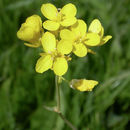Comments
provided by eFloras
Both
Brassica campestris and
B. rapa were simultaneously described by Linnaeus (Sp. Pl. 2: 666. 1753). Johann Metzger (Systematische Beschreibung der kultivirten Kohlarten. 68 pp. Heidelberg. 1833), who was the first to unite the two species, adopted
B. rapa for the combined species, and therefore this name has priority (St. Louis Code, Art. 11.5). Except for being an annual with nonfleshy taproots,
B. campestris is absolutely indistinguishable from the biennial
B. rapa with fleshy taproots. In fact, plants of
B. rapa that escape from cultivation fail to produce fleshy roots. Therefore,
B. campestris deserves no higher than a varietal rank of
B. rapa, and it is here reduced to synonymy under var.
oleifera.
Forms with 3- or 4-valved fruit have been recognized as Brassica trilocularis Roxburgh and B. quadrivalvis J. D. Hooker & Thomson, respectively. They were treated by Jafri (Fl. W. Pakistan 55: 24. 1973) as subspecies of B. napus, but both have 2n = 20, and therefore they should be recognized as a variety of B. rapa. Of the six varieties recognized in B. rapa, the following four are grown and naturalized in China.
- license
- cc-by-nc-sa-3.0
- copyright
- Missouri Botanical Garden, 4344 Shaw Boulevard, St. Louis, MO, 63110 USA
Description
provided by eFloras
Herbs annual or biennial, 30-120(-190) cm tall, glabrous or sparsely pubescent basally, rarely glaucous, sometimes with fleshy taproots. Stems erect, simple or branched above. Basal and lowermost cauline leaves petiolate, not rosulate or obscurely to strongly rosulate and forming a compact, oblong head; petiole (1-)2-10(-17) cm, slender or thickened and fleshy, sometimes strongly winged; leaf blade ovate, oblong, or lanceolate in outline, (5-)10-40(-60) × 3-10(-20) cm, margin entire, repand, dentate, or sinuate, sometimes pinnatifid or pinnatisect and with a large terminal lobe and smaller, 1-6, oblong or ovate lateral lobes on each side of midvein. Upper cauline leaves sessile, ovate, oblong, or lanceolate, 2-8(-12) × 0.8-3 cm, base amplexicaul, deeply cordate, or auriculate, margin entire or repand. Fruiting pedicels, straight, ascending or divaricate, (0.5-)1-2.5(-3) cm. Sepals oblong, (3-)4-6.5(-8) × 1.5-2 mm, ascending. Petals bright yellow, rarely pale or whitish yellow, 7-10(-13) × (2.5-)3-6(-7) mm, obovate, apex rounded. Filaments 4-6(-7) mm; anthers oblong, 1.5-2 mm. Fruit linear, (2-)3-8(-11) cm × 2-4(-5) mm, terete, sessile, divaricate or ascending; valvular segment (1.3-)2-5(-7.5) cm, 8-15-seeded per locule, valves with a prominent midvein; terminal segment conical, (0.3-)1-2.5(-3.5) cm, seedless or rarely 1-seeded; style obsolete. Seeds dark or reddish brown, globose, 1-1.8 mm in diam., minutely reticulate. Fl. Mar-Jun, fr. Apr-Jul. 2n = 20*.
- license
- cc-by-nc-sa-3.0
- copyright
- Missouri Botanical Garden, 4344 Shaw Boulevard, St. Louis, MO, 63110 USA
Habitat & Distribution
provided by eFloras
Cultivated. Throughout China [widely cultivated and naturalized elsewhere].
- license
- cc-by-nc-sa-3.0
- copyright
- Missouri Botanical Garden, 4344 Shaw Boulevard, St. Louis, MO, 63110 USA

